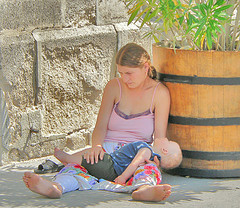 The Seattle Times recently did a multi-part series on the issue of homelessness in the area. One of the things that came to light in this series was that the fastest growing demographic entering the homeless life is that of parents with children. In addition to the obvious issues — lack of a roof and safety on the streets, having to care for multiple people, etc. — there are further downsides presented by the way that the homeless aid is structured.
The Seattle Times recently did a multi-part series on the issue of homelessness in the area. One of the things that came to light in this series was that the fastest growing demographic entering the homeless life is that of parents with children. In addition to the obvious issues — lack of a roof and safety on the streets, having to care for multiple people, etc. — there are further downsides presented by the way that the homeless aid is structured.
This excerpt from an anonymous editorial in the The Seattle Times series sums it up:
But homeless families face unique challenges. They’re often invisible to social-service agencies because they prefer to double up on a friend’s couch than to sleep on the street. Shelters are often already full, space taken by those on the long wait list for public housing and subsidized Section 8 housing.
Do a little Googling around, and you will find that this is true in many other places in the U.S. For instance, Florida and Pennsylvania are the two states that come up on top in search results.
It’s an unusual situation. Services are not optimized for family assistance. Sometimes the families still have vehicles or belongings they have managed to preserve. Addiction issues are nowhere near as prevalent. The list goes on.
As with the other homeless across the U.S., homeless families are in danger of simply being statistics to most people. This is why it is important to put faces on these dry facts, and allow the actual people in this state share their own narratives. Like with any social ill, it is important that we never forget the human faces and stories behind the facts and the figures.
This is why we publish works like downtTown USA: A Personal Journey with The Homeless and Maggots in my Sweet Potatoes: Women Doing Time. It is also why we were thrilled to see a lot of video material included in The Seattle Times series. Here are two clips, below. The first is about Cherie Moore and her 17-year-old son, Cody Barnes, who have been calling their Ford Ranger home.
Then there is Kim Ahern and her nine-year-old son Jack. After losing their home, they lived at Nickelsville, the only tent city in Washington’s King County that allows children to stay for more than the short term.
So, what are your thoughts on this disturbing trend? Do you know any families that have lost their homes? Do you have a story to share yourself, perhaps? We would love to hear what you are thinking, please leave a comment!
Source: “Shining a compassionate light on ‘Invisible Families’,” The Seattle Times, 09/12/10
Source: “The fastest-growing group among local homeless: families,” The Seattle Times, 08/28/10
Image by mcaretaker, used under its Creative Commons license.
Visit Us on Facebook: Humane Exposures Publishing , downTownUSA, Maggots in My Sweet Potatoes, It’s More Expensive To Do Nothing

 As we watch the economy spiral seemingly out of control, the specter of homelessness looms disturbingly close for people of all socioeconomic strata. Add in the chaos in the American housing market, and the picture becomes starkly unpleasant.
As we watch the economy spiral seemingly out of control, the specter of homelessness looms disturbingly close for people of all socioeconomic strata. Add in the chaos in the American housing market, and the picture becomes starkly unpleasant. Our very own Susan Madden Lankford was recently interviewed on Poverty Insights. For those unfamiliar with the website, here is a synopsis from its
Our very own Susan Madden Lankford was recently interviewed on Poverty Insights. For those unfamiliar with the website, here is a synopsis from its 







